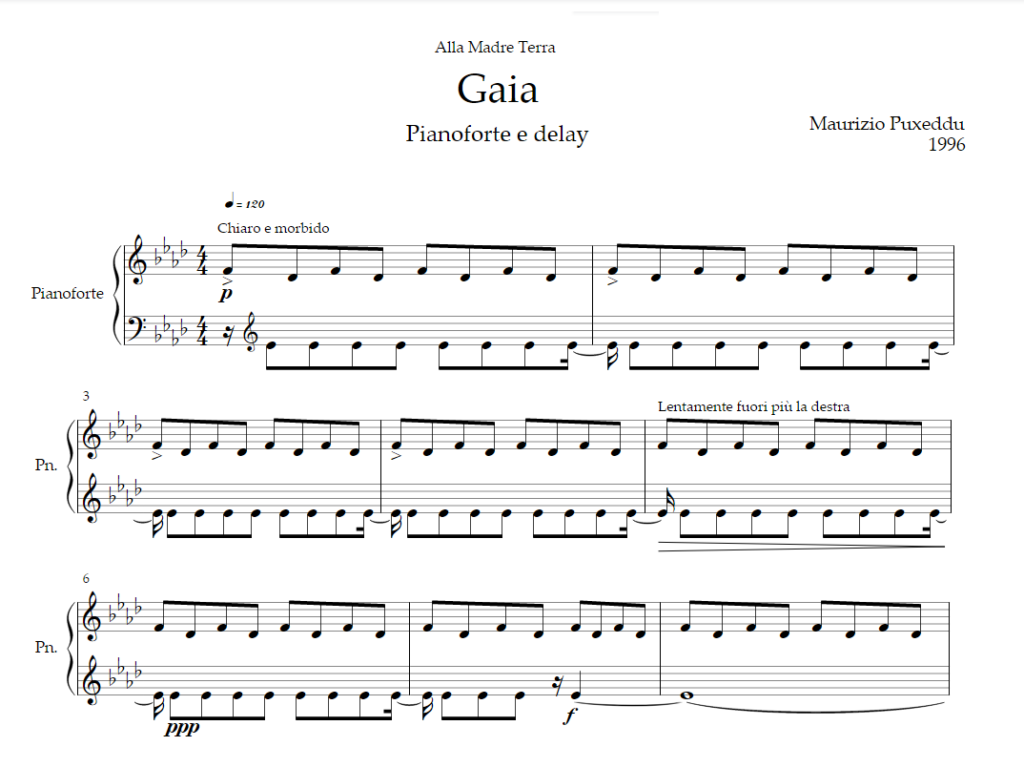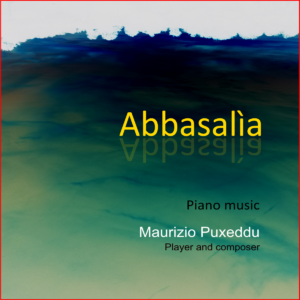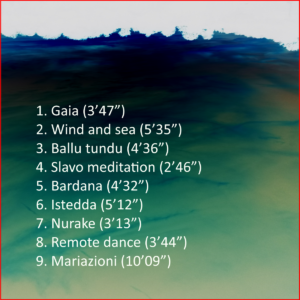Festival PORTA D’ORIENTE
E poi… la vita diventa magia… (VOYAGES)
VOYAGES – Percorsi e incontri dell’anima
VOYAGES – Percorsi e incontri dell’anima

Gaia from “Abbasalìa – Storie dal vento e dal mare”
From “Abbasalìa – Stories from the wind and the sea”
Maurizio Puxeddu, music and composition
Silvia Layla, dance and choreography
To Mother Earth
GAIA (Maurizio Puxeddu, 1996)
For piano and delay
————————————-
Gaia is a minimalist piece for piano and delay, it presents rhythmic repetitions and overlaps of elementary and minimal materials, associated with a delay – an electronic effect – which creates in real time a repetition of the sounds produced by the pianist.

The delay in GAIA is used to create a pulsating rhythmic grid, from the right to the left audio channel, on which the musician places all the sound materials and develops the musical discourse quietly, increasing and decreasing in a different way, between right and left hands, the dynamics and temporality of the sounds, between the sound of the piano and the one processed by the delay.
This registered version of GAIA is a theme to be developed. The live performer can afford variations and interactions, playing and relating with his action on the keys to the fixed rhythmic grid (delay), in a more important way than in recording, so as to shift the dynamic and temporal focus.
Listen to GAIA in the video for Abbasalìa – Stories from the wind and the sea
Abbasalìa, music from Sardinia
ABBASALÌA


Copyright © Maurizio Puxeddu (1996/2000)
The album entitled ABBASALÌA collects some musical pieces for piano, as they were improvised and recorded by Maurizio Puxeddu between 1996 and 2000. It was a preparatory work for something more articulated and complex, a bit like when a painter makes a first sketch, in pencil, pen or charcoal, of the work he intends to create in its entirety. Often, in these sketches there is all the pathos and the meaning of what we could perceive in the work that will eventually be created. We find the freshness of the creative and expressive act.
The recording took place with a piano, exactly with the same original instrument on which the pieces were conceived and composed. In the following years, various arrangements of these music were then prepared, for live musical performances in the following musical projects:
1996 – Aterusonus – Maurizio Puxeddu (launeddas, piano), Alessandro Garau (percussion), Adriano Orrù (double-bass)
1999 – The new launeddas – Maurizio Puxeddu (launeddas, accordion), Silvia Corda (piano), Adriano Orrù (double-bass), Massimo Cappai (soprano sax), Alessandro Corona (drum, percussion)
2000 – Intrecci – Maurizio Puxeddu (direction, composition, launeddas, piano, sound inventions, electronics), Enrico Di Felice (flutes), Roberto Pellegrini (percussion)
2000 – Mediterranea – Maurizio Puxeddu, Silvia Corda, Adriano Orrù, Roberto Pellegrini
2001 – Mediterranea – Maurizio Puxeddu (direction, composition, launeddas, piano), Enrico Di Felice (flutes), Roberto Pellegrini (percussion)
2002 – Keepers of the time – Maurizio Puxeddu (direction, composition and arrangements, piano, Sardinian guitar, bena ‘e corru, pitiolus), Gianluigi Trovesi (clarinets), Coro a Tenore “San Gavino” di Oniferi, Rossella Faa (voice), Enrico Di Felice (flute), Massimo Cappai (sax), Nicola Piras (sax), Giuseppe Orrù (launeddas), Renzo Zucca (launeddas), Fabrizio Meloni (cello), Pierpaolo Cardia (synth), Alberto Cabiddu (percussion), Alessandro Corona (drum), Massimo Tore (double-bass)
What you will hear on this album, finalized and released in 2020, are not the subsequent elaborations, but the original themes and sound developments.
Abbasalìa
1. Gaia (3’49”)
2. Wind and sea (5’37”)
3. Ballu tundu (4’38”)
4. Istedda (5’14”)
5. Bardana (4’34”)
6. Namuhni (2’50”)
7. Slavo meditation (2’48”)
8. Nurake (3’15”)
9. Remote dance (3’46”)
10. Mariazioni (9’42”)
Copyright © Maurizio Puxeddu (1996/2000)
Credits
Maurizio Puxeddu: Piano
Compositions by Maurizio Puxeddu
Audio and graphic editing by M.Puxeddu
For audio editing, the following were used:
(1996-2000) SYNTRILLIUM SOFTWARE Cool Edit PRO, EDIROL UA-5,
(2020) PRESONUS Studio One 4 Professional, PRESONUS StudioLive 32 III, PRESONUS Eris 5, Bowers & Wilkins 601 S2.
The piano used is a GENERALMUSIC Real Piano PRO 2.
In Gaia and Remote dance a delay was used in real time.
Acknowledgments
For the choice of the cover, I thank Enrico Di Felice because, advising me to rotate the inverted color photo I had submitted to him vertically, he turned on the light bulb. Look, it looks like a sea with foaming waves. Graphics also play their part and should have contextual meaning.
Abbasalìa, I can’t even read it!
When you read the title Abbasalìa you have the feeling of facing an unknown word and not knowing where to place the accent. It is like when you enter the water, the sea, and you go a little further where it is not touched. The water supports you but not too much, you falter.
It’s like walking on the tightrope rope. You have to decide in fractions of a second where and how to put the weight of your body balancing it with open arms, under penalty of the most ruinous fall.
Reading the title Abbasalìa makes your neurons move, because you also start asking yourself “what will it mean?”.
And try to decline the term with different inflections and accents, trying to reason about its specific and etymological origin: Abbasàlia, Abbàsalìa, Àbbasàlia, Abbasalià, Àbbasalìa …
I like this so much. 🙂


